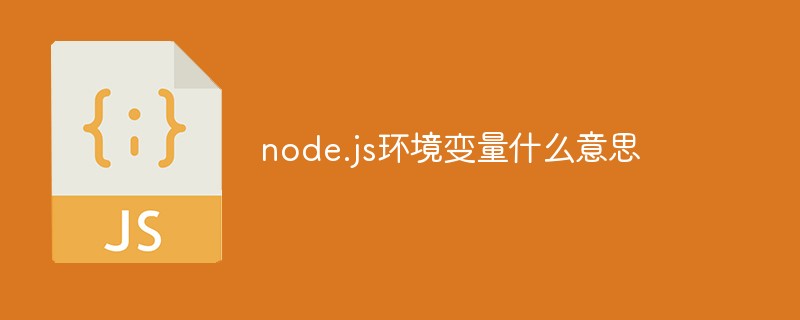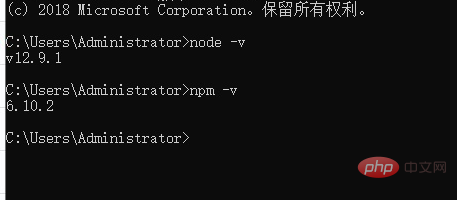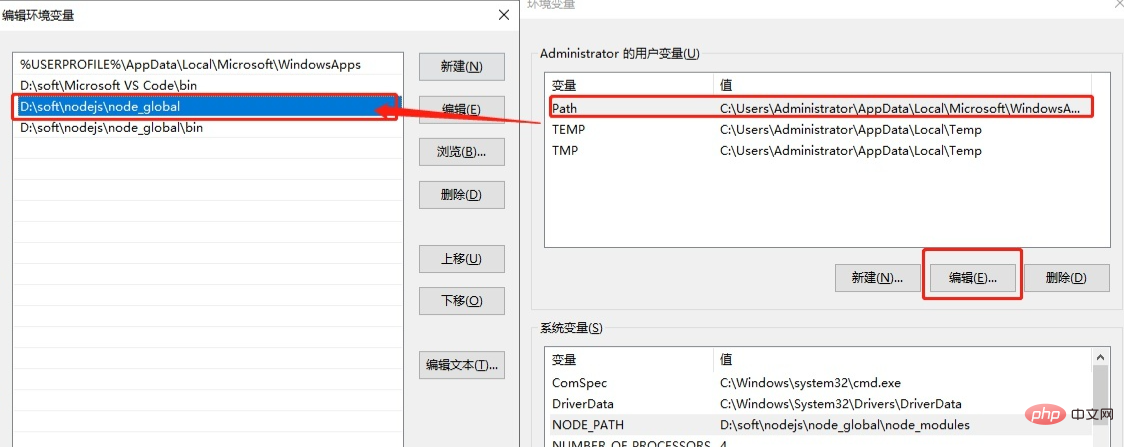What do node.js environment variables mean?
"node.js" environment variables refer to objects with specific names in the "node.js" running environment, that is, parameters of the running environment; environment variables are equivalent to some settings set for the system or user applications. Parameters, after installing node, you can add "G:\Node.js" to the system environment variable path.

The operating environment of this article: Windows 10 system, nodejs version 16, Dell G3 computer.
What does node.js environment variable mean?
An environment variable is an object with a specific name in the operating system, which contains one or more applications Information that will be used by the program.
Popularly understood as: some specified folder paths, the purpose is to find the desired files and folders more quickly and conveniently.
Environment variables are equivalent to some parameters set to the system or user applications, such as path, which tells the system when the system is asked to run a program without telling it the full path of the program. , the system should not only search for this program in the current directory, but also go to the path specified in path.
nodejs download and installation
Official website to download the corresponding system installation package
Be careful to modify the installation directory when installing. It is recommended to place it in a non-C drive directory. Just install it by default;
After the installation is complete, start the command line tool, enter node -vnpm -v to check the installation version, and if the version information is prompted, the installation is successful.

Environment configuration
Description: The environment configuration here mainly configures the path where the global module installed by npm is located, and the cache The cache path needs to be configured because when you execute an installation statement similar to: npm install module name [-g] in the future, the installed module will be installed to [C:\Users\username\AppData\Roaming\npm 】path, occupying C drive space.
This article installs nodejs in the D:\soft\nodejs directory. The following operations can be adjusted according to the actual installation directory.
In the installation directory, such as D:\soft\nodejs, create two new folders node_global (global package storage directory) and node_cache (cache directory);
Open the command line tool and perform the following two operations: npm config set prefix "D:\soft\nodejs\node_global" npm config set cache "D:\soft\nodejs\node_cache";
Configure environment variables:
Open System Properties-Advanced-Environment Variables, create a new variable name in the system variables: NODE_PATH, variable value: D:\soft\ nodejs\node_global\node_modules;
Edit the path of the user variable and change the default APPData/Roaming\npm under the C drive to D:\soft\nodejs\node_global;
Save it.


nodejs video tutorial"
The above is the detailed content of What do node.js environment variables mean?. For more information, please follow other related articles on the PHP Chinese website!

Hot AI Tools

Undresser.AI Undress
AI-powered app for creating realistic nude photos

AI Clothes Remover
Online AI tool for removing clothes from photos.

Undress AI Tool
Undress images for free

Clothoff.io
AI clothes remover

Video Face Swap
Swap faces in any video effortlessly with our completely free AI face swap tool!

Hot Article

Hot Tools

Notepad++7.3.1
Easy-to-use and free code editor

SublimeText3 Chinese version
Chinese version, very easy to use

Zend Studio 13.0.1
Powerful PHP integrated development environment

Dreamweaver CS6
Visual web development tools

SublimeText3 Mac version
God-level code editing software (SublimeText3)

Hot Topics
 1386
1386
 52
52
 How to delete node in nvm
Dec 29, 2022 am 10:07 AM
How to delete node in nvm
Dec 29, 2022 am 10:07 AM
How to delete node with nvm: 1. Download "nvm-setup.zip" and install it on the C drive; 2. Configure environment variables and check the version number through the "nvm -v" command; 3. Use the "nvm install" command Install node; 4. Delete the installed node through the "nvm uninstall" command.
 How to use express to handle file upload in node project
Mar 28, 2023 pm 07:28 PM
How to use express to handle file upload in node project
Mar 28, 2023 pm 07:28 PM
How to handle file upload? The following article will introduce to you how to use express to handle file uploads in the node project. I hope it will be helpful to you!
 How to do Docker mirroring of Node service? Detailed explanation of extreme optimization
Oct 19, 2022 pm 07:38 PM
How to do Docker mirroring of Node service? Detailed explanation of extreme optimization
Oct 19, 2022 pm 07:38 PM
During this period, I was developing a HTML dynamic service that is common to all categories of Tencent documents. In order to facilitate the generation and deployment of access to various categories, and to follow the trend of cloud migration, I considered using Docker to fix service content and manage product versions in a unified manner. . This article will share the optimization experience I accumulated in the process of serving Docker for your reference.
 An in-depth analysis of Node's process management tool 'pm2”
Apr 03, 2023 pm 06:02 PM
An in-depth analysis of Node's process management tool 'pm2”
Apr 03, 2023 pm 06:02 PM
This article will share with you Node's process management tool "pm2", and talk about why pm2 is needed, how to install and use pm2, I hope it will be helpful to everyone!
 Pi Node Teaching: What is a Pi Node? How to install and set up Pi Node?
Mar 05, 2025 pm 05:57 PM
Pi Node Teaching: What is a Pi Node? How to install and set up Pi Node?
Mar 05, 2025 pm 05:57 PM
Detailed explanation and installation guide for PiNetwork nodes This article will introduce the PiNetwork ecosystem in detail - Pi nodes, a key role in the PiNetwork ecosystem, and provide complete steps for installation and configuration. After the launch of the PiNetwork blockchain test network, Pi nodes have become an important part of many pioneers actively participating in the testing, preparing for the upcoming main network release. If you don’t know PiNetwork yet, please refer to what is Picoin? What is the price for listing? Pi usage, mining and security analysis. What is PiNetwork? The PiNetwork project started in 2019 and owns its exclusive cryptocurrency Pi Coin. The project aims to create a one that everyone can participate
 Let's talk about how to use pkg to package Node.js projects into executable files.
Dec 02, 2022 pm 09:06 PM
Let's talk about how to use pkg to package Node.js projects into executable files.
Dec 02, 2022 pm 09:06 PM
How to package nodejs executable file with pkg? The following article will introduce to you how to use pkg to package a Node project into an executable file. I hope it will be helpful to you!
 What to do if npm node gyp fails
Dec 29, 2022 pm 02:42 PM
What to do if npm node gyp fails
Dec 29, 2022 pm 02:42 PM
npm node gyp fails because "node-gyp.js" does not match the version of "Node.js". The solution is: 1. Clear the node cache through "npm cache clean -f"; 2. Through "npm install -g n" Install the n module; 3. Install the "node v12.21.0" version through the "n v12.21.0" command.
 Token-based authentication with Angular and Node
Sep 01, 2023 pm 02:01 PM
Token-based authentication with Angular and Node
Sep 01, 2023 pm 02:01 PM
Authentication is one of the most important parts of any web application. This tutorial discusses token-based authentication systems and how they differ from traditional login systems. By the end of this tutorial, you will see a fully working demo written in Angular and Node.js. Traditional Authentication Systems Before moving on to token-based authentication systems, let’s take a look at traditional authentication systems. The user provides their username and password in the login form and clicks Login. After making the request, authenticate the user on the backend by querying the database. If the request is valid, a session is created using the user information obtained from the database, and the session information is returned in the response header so that the session ID is stored in the browser. Provides access to applications subject to




